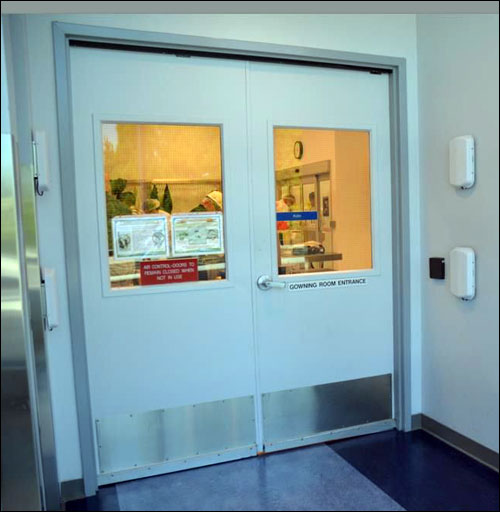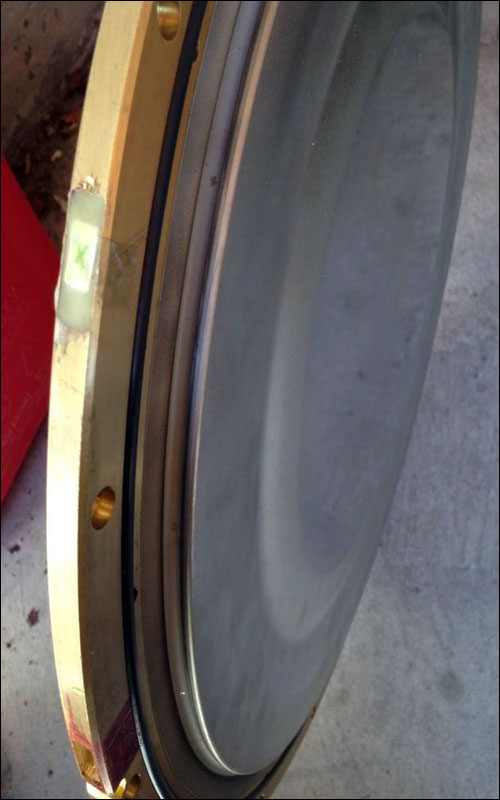California semiconductor-equipment manufacturer Applied Materials is gradually expanding a hybrid system that includes passive RFID tags and real-time location system (RTLS) technology to better manage where its equipment is located, as well as the compliance of its calibration procedures. The technology also enables the firm to better protect the intellectual property (IP) of its clients, by tracking in real time the exact locations of those clients’ products—typically, new semiconductors in the form of silicon wafers that Applied Materials uses to test the equipment it makes for those companies. The entire system—both hardware and software—was provided by Tagit Solutions.
Applied Materials, located in Santa Clara, manufactures equipment used in the production of semiconductors. At the Metal Deposition Products Group, the company creates tools used for depositing the necessary metals onto silicon wafers. The process of building these deposition tools requires highly sophisticated and expensive equipment.
Assets—such as targets (used to transfer metal to wafers), electrostatic-chucks (which hold wafers in place during the lithography process) and power supplies—used to make or test those tools are valued in the tens of thousands (or even millions) of dollars. Therefore, losing any item is a major cost to the company. In addition, the firm needs to track its inspections and tests for equipment that must be calibrated on a regular basis, and to enable its inspectors to quickly locate the tools requiring calibration. Finally, the ability to easily track and locate the high-value equipment makes it possible for Applied Materials to receive tax credits for a depreciated piece of equipment over time that it would not otherwise be able to claim without the technology to track equipment usage with in the lab.
The technology that makes all this possible includes both handheld and fixed RFID readers for tracking items fitted with EPC Gen 2 passive ultrahigh-frequency (UHF) tags, as well as active Wi-Fi tags that transmit information to the company’s existing Wi-Fi nodes. The technology was first installed four years ago as a very basic solution consisting of handheld readers, as well as tags affixed to a few items, so the company could begin tracking inventory in small numbers. Keeping the initial installation simple ensured that the solution would be up and running within six weeks, says Sandee Mukherjee, Tagit Solutions’ VP of business development. Applied Materials followed up with installing approximately seven fixed readers at doorways, and then added the RTLS functionality for tracking about 10 percent of its highest-value or most critical assets, along with customer IP. The company is now in the process of adding additional readers. Dinesh Saigal, the senior manager at Applied Materials’ application laboratory, described the installation at this year’s RFID Journal LIVE! conference and exhibition, held in April in Orlando, Fla. (see Smarter Operations in High Tech With RFID).
During his presentation, Saigal explained that his company must track test and measurement equipment in order to ensure ISO compliance. With RFID tags applied to the equipment, he explained, the inspectors who use those items can quickly locate them when needed.
For Applied Technology’s customers, Saigal said, RFID provides assurance that the whereabouts of their new products are being monitored. “What is a customer wafer worth?” Saigal commented, adding, “The IP is worth millions.” The companies are thus tagging boxes of wafers. RFID tags cannot be attached directly to the wafers themselves, he noted, since the tags are deemed too dirty to be taken into a “clean room” environment where Applied Materials tests the equipment it makes for fabricating chips from those wafers.
Chillers (coolers that Applied Materials uses during its processes) and other large equipment are also being tagged so the company knows if they are moved, and to what location. “Now we have control,” Saigal stated. “We know exactly what we have in the lab.” This, he added, enables the company to avoid purchasing new equipment that is not needed.
In selecting a solution, Applied Materials initially approached five RFID solution providers. “Two guys saw our problem and said they couldn’t help,” Saigal said. Three other companies, including Tagit, made offers, and Tagit was ultimately selected. According to Saigal, Applied Materials had been seeking a solution provider that would show some flexibility in providing a solution that could meet its specific needs, not just a copy of a system already provided to companies in other industries. “We’re not a warehouse,” he said. RF noise, for example, can pose a problem within the lab environment, with plasma-based work underway in the lab creating its own RF signal.
“You can’t just jump into the whole thing,” Saigal stated. “You have to plan it.”
Tagit developed a solution consisting of Motorola Solutions handheld readers for inventory tracking, with RFID portals consisting of Alien Technology ALR-9900+ fixed readers installed at doorways. Confidex and Xerafy passive EPC Gen 2 RFID tags are attached to all necessary equipment—about 1,700 items altogether—and Wi-Fi tags are attached to 10 percent of those of the highest value. Tagit’s software interprets and manages all collected read data and provides a dashboard that presents such information as the quantity of assets on hand, their movements and which assets may require replacement. The Tagit software also identifies each item’s location, using algorithms specific to this application.
When Applied Materials receives a piece of equipment or a target that it wishes to track, a worker attaches a passive UHF RFID tag to that item, or to the box in which it is stored. The tag’s unique ID number is linked to the item itself in Tagit’s software, residing on Applied Materials’ back-end system. For example, targets—which store metal (such as aluminum, copper or gold) that is deposited onto wafers—can be difficult to track without RFID. The targets are about the size of a hockey puck and, when used, are inserted into the metal application system. The target can often be used more than once, so it must then be stored in such a way that it can be located and reused. Otherwise, it will need to be replaced. By applying an RFID tag to the target’s storage box, Applied Materials can record every time that a target passes through a reader portal.
However, Applied Materials needed greater granularity to pinpoint not just the room in which a target was located, but also the specific rack and shelf. Therefore, Tagit applied passive UHF RFID “marker tags” to racks and shelves. The ID number encoded to each marker tag is stored in the software to indicate that specific location. Staff members walk past the racks and shelves while conducting inventory counts, and the reader captures the ID numbers of all tagged items (such as targets), as well those of the marker tags. A worker can use Tagit firmware on the handheld to determine the exact shelf and rack on which each item is stored. That data is then available on the software for users seeking a specific target for use or reuse.
“Just tracking those targets pays for the whole infrastructure,” Saigal said, since it spares the company from having to order replacement targets when other targets are still useable but cannot be located.
For more critical assets, Tagit installed the Wi-Fi-based RTLS solution. In this case, an RTLS tag is applied to each item that already has a passive UHF RFID tag to provide real-time data within specific sections of rooms. Applied Materials has a Wi-Fi network in place, provided by Aruba Networks. The tags transmit directly to that Wi-Fi network, and the Aruba system forwards the X and Y location coordinates to the Tagit software, which then identifies where within the building, or within a given room, a specific item is located. This can be valuable for tracking intellectual property, since it ensures that no customer’s silicon wafer is ever misplaced or confused with one belonging to another.
The technology can be used to quickly find equipment that must be calibration-tested. What’s more, workers can input data regarding each calibration test procedure, to be stored with the ID number on the item’s tag.
The company has taken a measured approach to the installation, Saigal told the audience at RFID Journal LIVE, warning that such RFID systems should be well planned before any installation takes place. He added that it is important to have full support from management, and from the employees who will be using the system.
In addition, Saigal said, although the technology requires little human intervention, someone at a company must take ownership of the solution, and manage its operation and the data provided by the software. “You need someone to oversee the system,” he stated.




